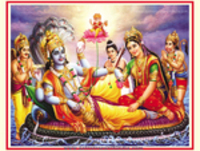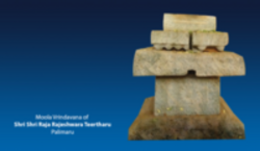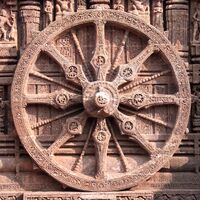Mangalaashtakam Verse 1:
लक्ष्मीर्यस्य परिग्रहः कमलभूः सूनुर्गरुत्मान् रथः
पौत्रश्चंद्रविभूषणः सुरगुरुः शॆषश्च शय्या पुनः ।
ब्रह्मांडं वरमन्दिरं सुरगणा यस्य प्रभॊः सॆवकाः
स त्रैलॊक्यकुटुंबपालनपरः कुर्याद्धरिर्मन्गलम् ॥ १ ॥
ಲಕ್ಷ್ಮೀರ್ಯಸ್ಯ ಪರಿಗ್ರಹಃ ಕಮಲಭೂಃ ಸೂನುರ್ಗರುತ್ಮಾನ್ ರಥಃ
ಪೌತ್ರಶ್ಚಂದ್ರವಿಭೂಷಣಃ ಸುರಗುರುಃ ಶೇಷಶ್ಚ ಶಯ್ಯಾ ಪುನಃ |
ಬ್ರಹ್ಮಾಂಡಂ ವರಮನ್ದಿರಂ ಸುರಗಣಾ ಯಸ್ಯ ಪ್ರಭೋಃ ಸೇವಕಾಃ
ಸ ತ್ರೈಲೋಕ್ಯಕುಟುಂಬಪಾಲನಪರಃ ಕುರ್ಯಾದ್ಧರಿರ್ಮನ್ಗಲಮ್ || ೧ ||
lakShmIryasya parigrahaH kamalabhUH sUnurgarutmaan rathaH
poutrashchaMdravibhUShaNaH suraguruH shEShashcha shayyaa punaH |
brahmaaMDaM varamandiraM suragaNaa yasya prabhOH sEvakaaH
sa trailOkyakuTuMbapaalanaparaH kuryaaddharirmangalam || 1 ||
Meaning:
May Lord Hari
– whose wife is Lakshmi
– whose son is the Lotus-born Brahma
– whose chariot is Garuda
– whose grandson is adorned with Chandra (Shiva)
– whose bed is Shesha
– who has the entire brahmAnda as his shrine or temple
– who has the entire pantheon of gods as his servants
– who is engrossed in nurturing the jIvas (living beings) in the three worlds as his family
(may this Lord) bless us with auspiciousness.
Sri Raja Rajeshwara Yati starts the mangalaashtaka with the very auspicious name of Lakshmi.
It is appropriate that the Lord is addressed as Hari. This is the form that frees us from sorrow and bondage (haratE iti hari). It may be noted that even NaaraayaaNa varma also starts with “hari”.
The Vishnu sahasranAma says the Lord is the purest of the pure, the most auspicious amongst all auspicious entities and most sacred amongst all sacred entities (pavitraanaaM pavitram, mangalaanaaM mangalam).
“Kamala” is also an epithet of Lakshmi. The author perhaps uses this name for a reason. At the beginning of creation, four forms emanated from the mula rUpa (Narayana). These forms are Aniruddha, Pradyumna, Sankarshana and Vasudeva. Lakshmi took on the forms of Shaanti, Kruti, Jayaa and Maayaa to serve the Lord. Brahma was born to Maaya and Vasudeva. Vaayu was born to Jayaa and Sankarshana. Saraswati and Bhaarati were born as twins to Kruti and Pradyumna. Thus the epithet ‘kamala bhU’ can mean Brahma, Vaayu, Saraswati and Bharati. Since the word ‘sUnu’ (son) is also used, we may restrict this to Brahma and Vaayu.
The author chooses the word “pari-graha” to indicate wife for a specific reason. The true meaning of ‘pari-graha’ or ‘paritaH grahya’ means one who is held from all sides. This is very true for Lakshmi and Vishnu because they are always together, at all times and in all places. The Lord is the source of Lakshmi’s strength and exalted position in the hierarchy of gods (“yasmaad brahma rudrendra devataanaam shriyOpi cha jnana sphoorthi sadaa tasmay haraye gurave namaH”) .



